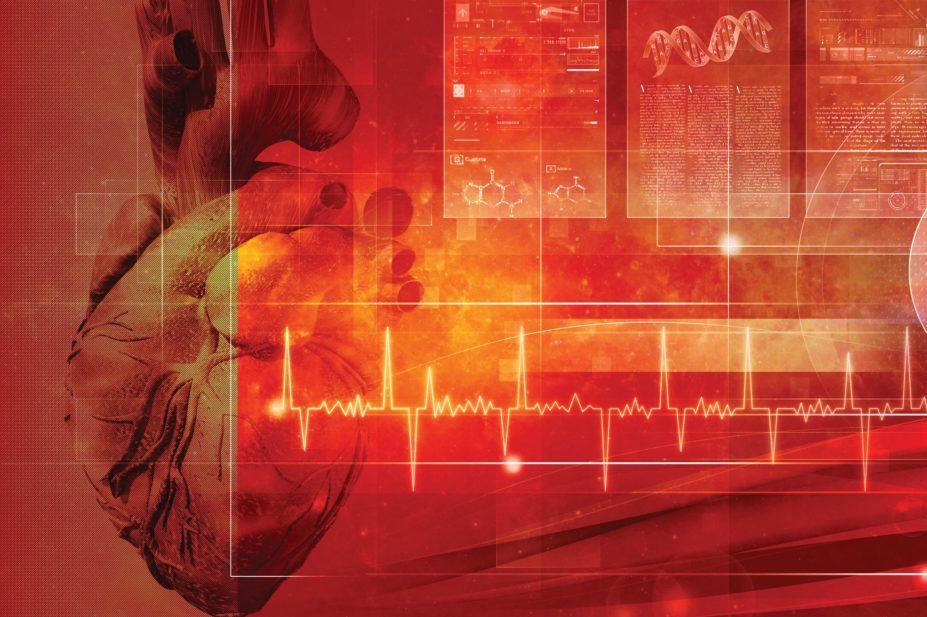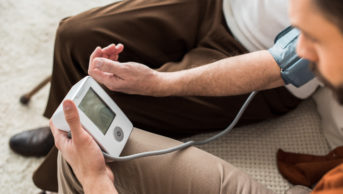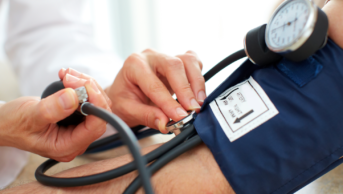
Helen Tolokonova / Alamy Stock Photo
Hypertension is the most common, preventable risk factor for cardiovascular events worldwide, and affects almost a third of all adults in England[1],[2]
,[3]
. Epidemiological data suggest that a 10mmHg reduction in systolic blood pressure (BP) across the population, regardless of baseline cardiovascular risk, could result in a 41% reduction in risk of stroke and 22% reduction in coronary heart disease[4]
. Despite this, only half of diagnosed hypertensive patients on treatment are deemed to have adequately controlled BP[2]
. Largely because of its asymptomatic nature, Public Health England (PHE) estimates that around 5.6 million adults in England are unaware of having elevated BP — these individuals are known as ‘undiagnosed hypertensives’[5]
.
In September 2017, community pharmacies up and down the country offered free BP checks to thousands of members of the public as part of ‘know your numbers’ week[6]
. In preparation, the staff at the Oxfordshire pharmacy where I practise, were keen to know more about BP measurement protocols; how to interpret the readings they were about to obtain; and what advice to give patients.
In the October 2017 issue of the Journal of Hypertension, we presented a systematic review and meta-analysis of published evidence that aimed to answer some of these questions[7]
. The study compared community pharmacy blood pressure (CPBP) measurements with general practitioner (GP) clinic, home blood pressure monitoring (HBPM) and ambulatory blood pressure monitoring (ABPM) readings in the same patients.
Evidence for the role of pharmacists in hypertension care
There is sufficient evidence to suggest that pharmacist management, or pharmacist and GP co-management, of hypertension can reduce BP compared with usual care alone. For instance, a systematic review of randomised controlled trials identified 16 studies of ‘community pharmacist interventions on control of BP in hypertensive patients’[8]
. The nature of the interventions across the studies included: establishing and improving adherence to BP medications; early identification of drug-related problems and side effects; optimal drug selection for individual patients; and practical diet and lifestyle advice, including stop-smoking schemes.
Across the studies, systolic BP reduction in the pharmacy intervention arms were clinically significant, showing a -6.1mmHg (95% confidence interval (CI): -8.4 to -3.8) difference compared with usual GP care. To provide some context, an antihypertensive drug such as a thiazide diuretic, prescribed at a normal maintenance dose, is expected to decrease systolic BP by 8mmHg on average[4]
.
Furthermore, targeted cardiovascular risk assessments in pharmacies have shown potential in screening and referring high-risk patients to general practice[9]
.
Considering this information, and the increasingly clinical roles pharmacists are taking on, the ability to accurately take and interpret BP has never been more important.
Standardising blood pressure measurements in pharmacies
Variations in BP measurement techniques can have a substantial effect on blood pressure readings and, consequently, clinical decisions. Table 1 shows some of the common factors that can influence BP readings and their estimated effect on the results.
In our review, mean CPBP was calculated from a wide range of visits to the pharmacy (one to five visits) as well as from a range of repeat readings taken per visit (two to six readings) within each study. Furthermore, the protocol for calculating the mean (whether the first reading is discarded) and the member of the pharmacy team taking the readings varied.
The effects of these differences were partially reflected in the systolic BP comparisons, which suggested that the more readings and repeat visits, the closer the correlation between pharmacy and out-of-office measurements[7]
. Higher numbers of repeat readings have been shown to lead to a ‘regression to the mean’ effect and hence a closer relationship to the multiple readings taken via HBPM and ABPM[10]
.
| Factors | Estimated average effect on systolic blood pressure (mmHg) |
|---|---|
| Patient talking during measurement[11] | +17 |
| Full bladder/urge to urinate during measurement[12] | +15 |
| Consumption of alcohol in the three hours prior to reading[13] | +8 |
| Legs crossed during readings[14] | +7 |
| Observed reading vs unattended reading (patient alone in the consultation room)[15] | +5 to +16 |
| Consumption of caffeinated drink one hour prior to reading[16] | +3 to +15 |
| Cuff one size too small[17] | +2 to +6 |
| No arm support during reading[18] | +2 |
The differences in the way BP was measured across the studies highlighted the fact that, currently, neither the Royal Pharmaceutical Society (RPS) nor the World Health Organization (WHO) recommend a standardised protocol for the measurement of blood pressure in pharmacies[19],[20]
.
With workloads in pharmacies increasing, requesting that patients return to the pharmacy on several occasions within a short period of time may not be convenient for either party. Equally, taking up to six repeated BP measurements (with a one-minute break between each) may be time consuming and not conducive to an effective overall consultation. Therefore our study recommends a pragmatic approach to measurements, involving triplicate readings, discarding the first reading and taking an average of measurements two and three when the initial reading is deemed high.
Some studies used non-validated monitors to estimate CPBP, such as wrist devices[21]
. We encourage pharmacy teams and patients to ensure that their BP monitors are validated by verifying on the British and Irish Hypertension Society website, and ensuring manual devices are used for patients with atrial fibrillation.
.
Interpreting readings taken in pharmacies
How should we interpret BP readings taken in pharmacies? Thresholds of 140/90mmHg (GP clinic) and 135/85mmHg (daytime ABPM/HBPM) are currently adopted for hypertension diagnosis and management among non-diabetic adults under the age of 80 years[23],[24]
. The RPS and the WHO have previously recommended the 140/90mmHg threshold for the diagnosis of elevated blood pressure in pharmacies [19],[20]
. This threshold, however, is based on the assumption that pharmacies, as clinically related settings, are associated with the same ‘white coat effect’ as GP clinics, rather than on diagnostic accuracy or comparison studies.
(Pooled analysis in our systematic review showed no significant difference between CPBP and daytime ABPM readings (mean difference 1.6mmHg (95% CI: -1.2 to 4.3)), and that mean BPs recorded in pharmacies were significantly higher than 24-hour ABPM readings (mean difference 7.8mmHg (95% CI: 1.5 to 14.1)). In other words, pharmacy readings were shown to be no different to daytime ABPM readings, and higher than 24-hour ABPM readings. This pattern was further confirmed with the CPBP/HBPM comparison (mean difference 2.4mmHg (95% CI: 0.0 to 4.8)) where no clinically significant difference (±5mmHg) was observed.
The three comparisons above indicate that CPBP may be best interpreted using out-of-office BP thresholds (i.e. 135/85mmHg) rather than the commonly adopted 140/90mmHg clinic threshold. In keeping with this interpretation, we would expect CPBP readings to be significantly lower than GP clinic measurements; however, this was not observed and no significant difference was found (mean difference -0.9mmHg (95% CI: -3.5 to +1.7)).
The reasons for this inconsistency lie partly in the variety of BP measurements used in the studies. For example, only two of the six studies comparing GP clinic with pharmacy readings were taken by GPs themselves. The rest involved either nurses, research assistants or automated unattended measurements. To exemplify the potential impact of these differences, a systematic review demonstrated that clinic readings taken by nurses can be up to 7.0mmHg lower than GP-measured readings (95% CI: -4.7 to -9.2)[25]
.
Conclusion
Currently, elevated BP readings taken in community pharmacies result in either referral to a GP or advice to the patient, rather than formal diagnosis or regular monitoring. Given this context and the data collected, CPBP readings may be best interpreted using the home/daytime ABPM threshold for the diagnosis and management of hypertension (135/85mmHg).
This approach would likely result in a higher sensitivity (true positive rate) for detecting hypertension when referring patients to their GP with borderline elevated BP, albeit at the expense of specificity (false positive rate). To avoid an increase in GP workload through inappropriate referral, pharmacies could consider directing patients toward home or daytime ABPM to further refine referral criteria after elevated CPBP readings.
Staff at the pharmacy where I practise were able to successfully engage with the ‘know your numbers’ week, offering blood pressure measurements and advice to help patients reduce their BP, and have continued to do this beyond the promotional week. If pharmacies can continue to demonstrate their value in hypertension detection and management, we hope that future service development can be focused on setting up the necessary infrastructure to formally allow pharmacists to manage patients with hypertension from community settings.
References
[1] World Health Organization: A global brief on hypertension: silent killer, global public health crisis. Geneva, Switzerland. 2013. Available at: http://ish-world.com/data/uploads/global_brief_hypertension.pdf (accessed January 2018)
[2] Health Survey for England Joint Health Surveys Unit. In: Department of Epidemiology and Public Health Unit: Health and Social Care Information Centre. 2013. Available at: https://digital.nhs.uk/catalogue/PUB16076 (accessed January 2018)
[3] Wilkins E, Wilson L, Wickramasinghe K et al. European cardiovascular disease statistics 2017. European Heart Network, Brussels. 2017. Available at: http://www.ehnheart.org/images/CVD-statistics-report-August-2017.pdf (accessed January 2018)
[4] Law M, Morris J & Wald N. Use of blood pressure lowering drugs in the prevention of cardiovascular disease: meta-analysis of 147 randomised trials in the context of expectations from prospective epidemiological studies. BMJ 2009;338:b1665. doi: 10.1136/bmj.b1665
[5] Evans T & Hughes A. Public Health England. Hypertension prevalence estimates in England: estimated from the Health Survey for England. 2016. Available at: https://www.gov.uk/government/uploads/system/uploads/attachment_data/file/612309/HypertensionprevalenceestimatesinEnglandestimate.pdf (accessed January 2018)
[6] Blood Pressure UK. Know your numbers 2017. Available at: http://www.bloodpressureuk.org/microsites/kyn/Home/AboutKYN (accessed January 2018)
[7] Albasri A, O’Sullivan J, Roberts N et al. A comparison of blood pressure in community pharmacies with ambulatory, home and general practitioner office readings: systematic review and meta-analysis. J Hypertens 2017;35(10):1919–1928. doi: 10.1097/HJH.0000000000001443
[8] Cheema E, Sutcliffe P & Singer D. The impact of interventions by pharmacists in community pharmacies on control of hypertension: a systematic review and meta-analysis of randomized controlled trials. Br J Clin Pharmacol 2014;78(6):1238–1247. doi: 10.1111/bcp.12452
[9] Horgan J, Blenkinsopp A & McManus R. Evaluation of a cardiovascular disease opportunistic risk assessment pilot (‘Heart MOT’ service) in community pharmacies. J Public Health (Oxf) 2010;32(1):110–116. doi: 10.1093/pubmed/fdp092
[10] Morton V & Torgerson D. Effect of regression to the mean on decision making in health care. BMJ 2003;326(7398):1083–1084. doi: 10.1136/bmj.326.7398.1083
[11] Le Pailleur C, Helft G, Landais P et al. The effects of talking, reading, and silence on the “white coat” phenomenon in hypertensive patients. Am J Hypertens 1998;11(2):203–207. doi: 10.1016/S0895-7061(97)00403-2
[12] Fagius J & Karhuvaara S. Sympathetic activity and blood pressure increases with bladder distension in humans. Hypertension 1989;14(5):511–517. Available at: https://www.ncbi.nlm.nih.gov/pubmed/2807512 (accessed January 2018)
[13] Potter J, Watson R, Skan W et al. The pressor and metabolic effects of alcohol in normotensive subjects. Hypertension 1986;8(7):625–631. Available at: https://www.ncbi.nlm.nih.gov/pubmed/3522422 (accessed January 2018)
[14] Adiyaman A, Tosun N, Elving L et al. The effect of crossing legs on blood pressure. Blood Press Monit 2007;12(3):189–193. doi: 10.1097/MBP.0b013e3280b083a7
[15] Kjeldsen S, Lund-Johansen P, Nilsson P et al. Unattended blood pressure measurements in the systolic blood pressure intervention trial: implications for entry and achieved blood pressure values compared with other trials. Hypertension 2016;67(5):808–812. doi: 10.1161/hypertensionaha.116.07257
[16] Mort J & Kruse H. Timing of blood pressure measurement related to caffeine consumption. Ann Pharmacother 2008;42(1):105–110. doi: 10.1345/aph.1K337
[17] Sprafka J, Strickland D, Gomez-Marin O et al. The effect of cuff size on blood pressure measurement in adults. Epidemiology 1991;2(3):214–217. Available at: https://www.ncbi.nlm.nih.gov/pubmed/2054405 (accessed January 2018)
[18] Waal-Manning H & Paulin J. Effects of arm position and support on blood-pressure readings. J Clin Hypertens 1987;3(4):624–630. Available at: https://www.ncbi.nlm.nih.gov/pubmed/3453393 (accessed January 2018)
[19] Royal Pharmaceutical Society. Monitoring blood pressure: a quick reference guide. 2011 [no longer available online]
[20] World Health Organization. Pharmacy-based hypertension management model: protocol and guidelines. Copenhagen, Denmark. 2005. Available at: http://apps.who.int/iris/bitstream/10665/107638/1/E85730.pdf (accessed January 2018)
[21] Mutlu S, Sari O, Arslan E et al. Comparison of ambulatory blood pressure measurement with home, office and pharmacy measurements: is arterial blood pressure measured at pharmacy reliable? J Eval Clin Pract 2016;22(1):40–45. doi: 10.1111/jep.12424
[22] British and Irish Hypertension Society. Blood pressure monitor validation 2017. Available at: http://bhsoc.org/bp-monitors/bp-monitors (accessed January 2018)
[23] Mancia G, Fagard R, Narkiewicz K et al. 2013 ESH/ESC guidelines for the management of arterial hypertension. Blood Pressure 2013;22(4):193–278. doi: 10.1093/eurheartj/eht151
[24] National Institute for Health and Care Excellence. Hypertension in adults: diagnosis and management. Clinical guideline [CG127]. 2011. Updated November 2016. Available at: https://www.nice.org.uk/guidance/cg127 (accessed January 2018)
[25] Clark CE, Horvath IA, Taylor RS et al. Doctors record higher blood pressures than nurses: systematic review and meta-analysis. Br J Gen Pract 2014;64(621):e223–232. doi: 10.3399/bjgp14X677851


